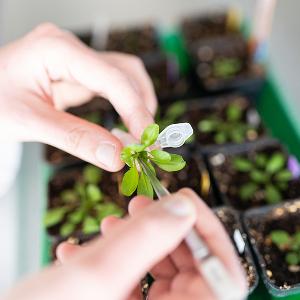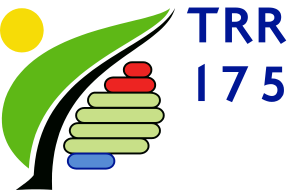
Pflanzenwissenschaften
Unsere Forschung untersucht, wie Pflanzen auf molekularer Ebene Umweltreize erfassen und darauf reagieren – mit besonderem Fokus auf die Funktion der Chloroplasten, die Steuerung der Genexpression sowie die metabolische Anpassung zur Optimierung von Stressresistenz und Leistungsfähigkeit.
Pflanzenwissenschaften
Wir analysieren die molekularen Prozesse, die Pflanzen befähigen, auf Umweltveränderungen zu reagieren – vor allem im Bereich der Genregulation, Photosynthese und Stressanpassung. Ein zentraler Aspekt ist die Funktion der Chloroplasten, einschließlich der Rolle von Transportproteinen bei der Steuerung des Ionentransports sowie der Kommunikation zwischen plastidären und nukleären Genomen. Darüber hinaus erforschen wir die zelluläre Kompartimentierung und die dynamische Kontrolle pflanzlicher Stoffwechselnetzwerke mithilfe systembiologischer, genetischer und mikroskopischer Ansätze.
Professuren und Servicegruppen
- Molekulare Zellbiologie der Pflanzen (Prof. Dr. Wolfgang Frank)
- Pflanzenmetabolismus (Prof. Dr. Peter Geigenberger)
- Pflanzliche Entwicklungsbiologie (Prof. Dr. Andreas Klingl)
- Biochemie & Physiologie der Pflanzen (Prof. Dr. Hans-Henning Kunz)
- Molekularbiologie der Pflanzen/Botanik (Prof. Dr. Dario Leister)
- Evolutionäre Zellbiologie der Pflanzen (Prof. Dr. Thomas Nägele)
- Molekulare Pflanzenwissenschaften (Prof. Dr. Jörg Nickelsen)
- Metabolomics (Dr. Martin Lehmann)
- Proteomics (PD Dr. Serena Schwenkert)
Schlüsselpublikationen
Csicsely E, Oberender A, Georgiadou AS, Alz J, Kiel S, Gutsche N, Zachgo S, Grünert J, Klingl A, Top O, Frank W (2025) Identification and characterization of DICER-LIKE genes and their roles in Marchantia polymorpha development and salt stress response. Plant J 121: e17236. doi: 10.1111/tpj.17236.
Seydel C, Heß M, Schröder L, Klingl A, Nägele T (2025) Subcellular plant carbohydrate metabolism under elevated temperature. Plant Physiol 198: kiaf117. doi: 10.1093/plphys/kiaf117.
Watzlowik MT, Silberhorn E, Das S, Singhal R, Venugopal K, Holzinger S, Stokes B, Schadt E, Sollelis L, Bonnell VA, Gow M, Klingl A, Marti M, Llinás M, Meissner M, Längst G (2025) Plasmodium blood stage development requires the chromatin remodeller Snf2L. Nature 639: 1069-1075. doi: 10.1038/s41586-025-08595-x.
Ostermeier M, Garibay-Hernández A, Holzer VJC, Schroda M, Nickelsen J (2024) Structure, biogenesis, and evolution of thylakoid membranes. Plant Cell 36: 4014-4035. doi: 10.1093/plcell/koae102.
Hou LY, Sommer F, Poeker L, Dziubek D, Schroda M, Geigenberger P (2024) The impact of light and thioredoxins on the plant thiol-disulfide proteome. Plant Physio 195: 1536-1560. doi: 10.1093/plphys/kiad669.
Tang Q, Xu D, Lenzen B, Brachmann A, Yapa MM, Doroodian P, Schmitz-Linneweber C, Masuda T, Hua Z, Leister D, Kleine T (2024) GENOMES UNCOUPLED PROTEIN1 binds to plastid RNAs and promotes their maturation. Plant Commun 5: 101069. doi: 10.1016/j.xplc.2024.101069
Penzler JF, Naranjo B, Walz S, Marino G, Kleine T, Leister D (2024) A pgr5 suppressor screen uncovers two distinct suppression mechanisms and links cytochrome b6f complex stability to PGR5. Plant Cell 36: 4245-4266. doi: 10.1093/plcell/koae098.
Kunz HH, Armbruster U, Mühlbauer S, de Vries J, Davis GA (2024), Chloroplast ion homeostasis – what do we know and where should we go? New Phytol 243:543-559
Knoblauch J, Waadt R, Cousins AB, Kunz HH (2024) Probing the in situ volumes of Arabidopsis leaf plastids using three-dimensional confocal and scanning electron microscopy. Plant J 117:332-341. doi: 10.1111/tpj.16554.
Leister D, Sharma A, Kerber N, Nägele T, Reiter B, Pasch V, Beeh S, Jahns P, Barbato R, Pribil M, Rühle T (2023) An ancient metabolite damage-repair system sustains photosynthesis in plants. Nat Commun 14: 3023. doi: 10.1038/s41467-023-38804-y.
Leister D (2023) Enhancing the light reactions of photosynthesis: Strategies, controversies, and perspectives. Mol Plant 16: 4-22. doi: 10.1016/j.molp.2022.08.005. Epub 2022 Aug 22.
Howell AH, Völkner C, McGreevy P, Jensen KH, Waadt R, Gilroy S, Kunz HH, Peters WS, Knoblauch M (2023) Pavement cells distinguish touch from letting go. Nat Plants 9: 877-882. doi: 10.1038/s41477-023-01418-9
DeTar RA, Höhner R, Manavski N, Blackholm M, Meurer J, Kunz HH (2022) Loss of SALT OVERLY SENSITIVE 1 prevents virescence in chloroplast K+/H+ EFFLUX ANTIPORTER-deficient mutants. Plant Physiol 189: 1220-1225. doi: 10.1093/plphys/kiac142.
Kooperationen



